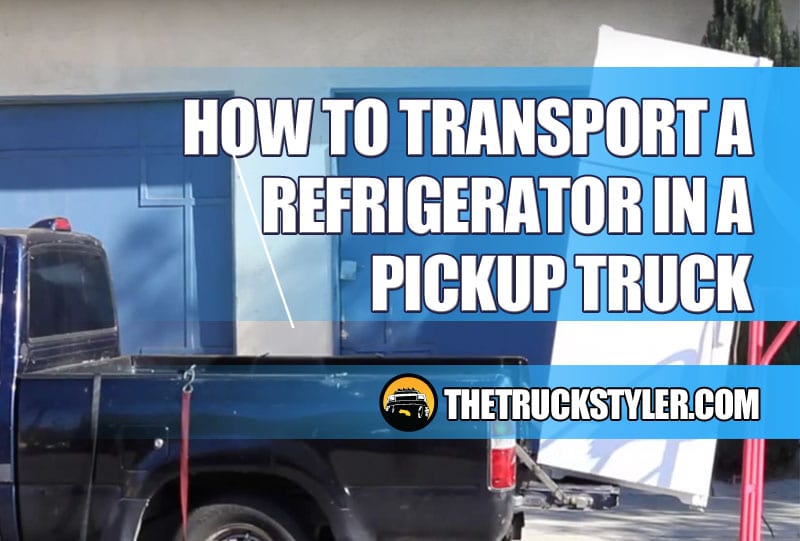One of the great things about owning a pickup truck is that you are in complete control when it comes to moving to a new house or taking stuff to the city dump. But the flip side to this is that everyone you know will ask you to help them move heavy items, including refrigerators (preferably without damaging them).
It’s actually not that hard to do when you know how, and in real simple terms, knowing how to transport or move a refrigerator in your pickup truck goes something like this:
To transport a refrigerator in a truck you should use a dolly to load it and then set the fridge upright flush against the cab wall in the bed. You will then need to use ratchet straps to anchor and tie down the refrigerator safely before driving.
In this guide to moving refrigerators with a truck I am going to cover all the steps to follow so you will know:
- How to move the refrigerator without damaging floors and walls in the property
- How to get it down the stairs if you need to
- How to load the refrigerator onto the truck bed without damaging it or your vehicle
- How to tie down the refrigerator in your pickup truck securely for transport
- How to drive when you have a heavy load on board
- How to take the refrigerator out of the truck without scratching anything
Now let’s get into it a little more detail.
#1: Prepare the Refrigerator for Transport
Starting with the obvious I know, but you will need to empty the refrigerator out.
Please resist the temptation to be lazy and not prepare the fridge; if you don’t do this part you will regret it.
This aspect involves removing any food and drink bottle and ice. Chip away at the ice beforehand and get as much out as possible as it could end up leaking over your truck and the appliance’s electrics when in transport.
Handy Hint: In an ideal world you would let the freezer defrost completely for at least 8 hours moving it onto your truck to prevent water leaks from the appliance.
Any trays or removeable sections should also be taken out and placed in a box which you can then put in the truck’s cabin for later on.
I also recommend wrapping internal trays and drawers in towels or cloth before packing, as it will protect them from possible scratches and cracking.
#2: Secure Cables and Doors Using Cords or Straps
Now unplug the electrical cord and any water source pipes if it has an ice machine, wrap those tightly, tape together and wedge them into the back of the refrigerator. You should spot somewhere in the back system where you can slot them.
And here’s the key part you should never miss:
You need to secure the door to the refrigerator, as this will stop it swinging open whilst being moved from the property, or even whilst in the back of your truck.
The best way I have found to do this is by using bungee cords or ratchet straps.
Your strapping or cords will need to go around the whole of the refrigerator, but not too tight as this can mis-align the door hinges.
Handy Hint: If you value your refrigerator and truck and don’t want to chance scratching them, I would also recommend wrapping the fridge in blankets to add an extra layer of protection.
You’re now ready to move the refrigerator out of the property and into your truck.
#3: Moving the Refrigerator from the Property Safely
The best thing you could ever use here would be a moving dolly (also known as a hand truck) … aside from a couple of friends to help you of course.
You can buy them (a dolly, not friends!) on Amazon relatively cheaply or rent them, but just make sure to use one which has a base large enough to take as much of the fridge’s footprint as possible.
The dolly I recommend is a specialist one for appliances and can handle up to 800 pounds which is more than enough for even the largest of refrigerators.
It’s called the Harper Trucks Appliance Dolly and comes with security belts and a stair climber function.
Slide the refrigerator onto the moving dolly and as an optional safety measure, use some strapping or cords again to fix it to the rear of the dolly where the handles are.
Once the refrigerator is safely on the moving dolly, tilt it backwards until you can take the weight.
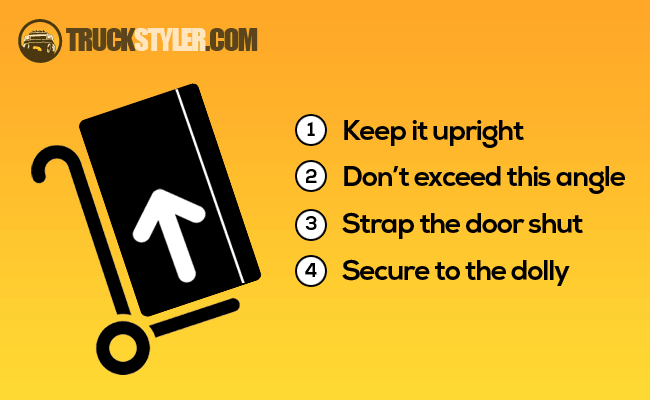
Handy Hint: Do not tilt it so it’s horizontal. If you do that then the oil in the refrigerator’s compressor could leak into the cooling tubes, damaging the fridge.
You can now wheel the refrigerator out of the property with the support of a second or third person to help with guidance.
If there are steps or stairs that you need to negotiate, then go just one step at a time.
I recommend two people at the front who take the weight of the refrigerator, with a third person at the rear who eases the dolly down onto each sequential step.
Don’t do this part too quickly.
#4: Prepare Your Pickup Truck for Transport
Before you even thinking about hauling the refrigerator up into the bed of your pickup truck you need to do a little preparation.
It’s going to be positioned against the back of the pickup truck’s cab, so remove any obstacles from the bed, making sure it’s completely clear and free of any other items.
Make sure that there is enough space for the refrigerator to stand upright in your pickup truck.
Once the bed is clear you can then drape a blanket over the lip of the open tailgate. This will help you move the refrigerator in smoothly and reduce the chances of any scratches to either the fridge or your truck.
Now back the truck up towards the driveway or pavement of the property you are moving from.
Back up as much as possible so the truck wheels touch the gutter and curb drop. This will help to get the tailgate closer to the ground, making lifting easier.
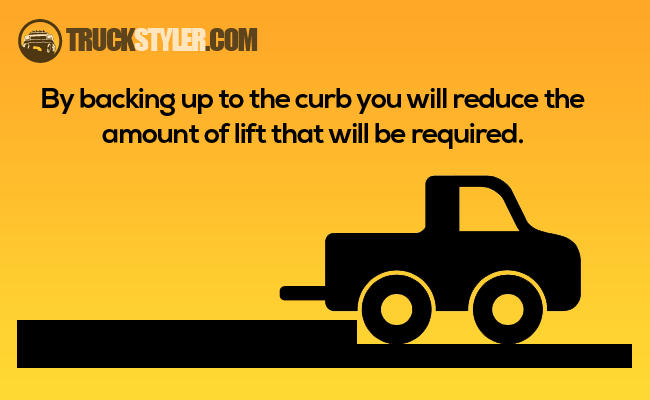
Handy Hint: If you can get hold of a truck ramp this will make the next step on loading the refrigerator much easier and will drastically reduce the chance of damage and scratching.
#5: Get the Refrigerator into Position
I am going to assume you don’t have a truck ramp at this point, so you’re going to be lifting the refrigerator straight up into the bed of the pickup with the help of some friends.
Before you can do that, back the dolly up to the pickup’s tailgate.
The dolly should ideally be flush up against the lip of the truck bed or tailgate.
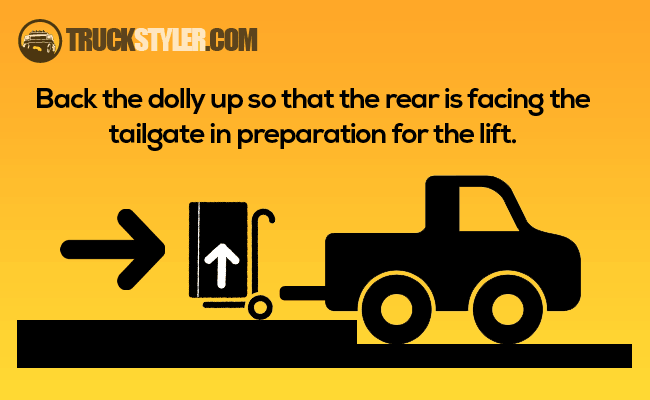
#6: Loading the Refrigerator into the Pickup Truck
And here’s the hard part as it’s where 90% of refrigerators get damaged when being transported in a pickup truck. You need to take extra special care.
If you follow this step, it should be way easier for you and limit the risk of damage.
Here’s how you do it if you don’t have a ramp.
Handy Hint: When loading a fridge onto a truck with a ramp, it’s best to go up backwards with one person in front of the refrigerator and a second person behind to help push it up.
Two people will need to stand outside the truck and either side of the refrigerator, whilst you stand in the bed of the pickup truck, above the fridge.
In one coordinated effort, the you will lift the dolly handles upwards, whilst the two people on the ground lift from the base of the refrigerator.
Once the refrigerator base is parallel to the tailgate or bed, you will pull the dolly backwards towards you at a slight angle as the two people on the ground push the fridge into the bed.
If possible, this should be one smooth action that occurs in one go.
Handy Hint: It can help to have a fourth person in the bed too to help ensure that the heavy refrigerator doesn’t tip backwards onto the dolly operator doing the pulling.
Now using the dolly, back the refrigerator against the front cab, still remaining upright.
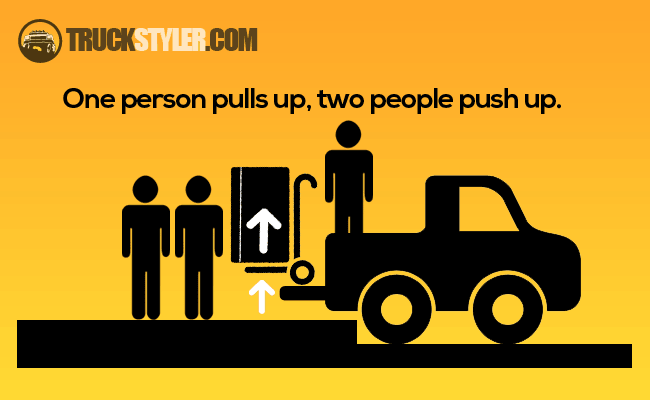
If possible, leave the refrigerator on the dolly as it will help you when you get to your destination and will make the strapping and tie down process in the next section more secure.
If you need to remove the dolly, you will need to swivel the refrigerator around before you push it back against the cab wall of the pickup truck bed.
Handy Hint: Place a large piece of cardboard against the external cab wall to protect your pick up and fridge from damage as well as blankets covering the refrigerator.
#7: Tie Down the Refrigerator in the Pickup Truck
Now the refrigerator is in position and still upright, it will need to be strapped and tied down securely.
There’s a good way and a not so good way of doing this.
The not so good way is to use bungee cords.
Yes, it can work, but it won’t be as secure, which is why I recommend using ratchet straps (view on Amazon) as you will get a far better tie down and tighter strapping.
Handy Hint: If you don’t have ratchet straps then brace the refrigerator with other heavy items that you are transporting on your pickup truck.
Before you tie down the refrigerator for transport, check the working load limit of your ratchet straps, as well as for any signs of wear and tear.
For a guide to working load limits and the minimum breaking strength of ratchet straps take a look at this information on the Safety Lifting Gear website.
In simple terms you just want to make sure that the working load limit of your straps can handle the weight of your refrigerator. The straps that I recommend on Amazon should be ample enough for most residential sized fridge freezers.
Because the refrigerator is stood upright in the truck’s bed, it’s quite a tall item. That means you will need to tie-down from two sides at least.
To do this, take one ratchet strap and go over the top of the refrigerator and the second strap goes around the front of the fridge to pull it closer to the cab wall.
Both ratchet straps will need to be connected to anchor points in your truck bed and then tightened up securely.
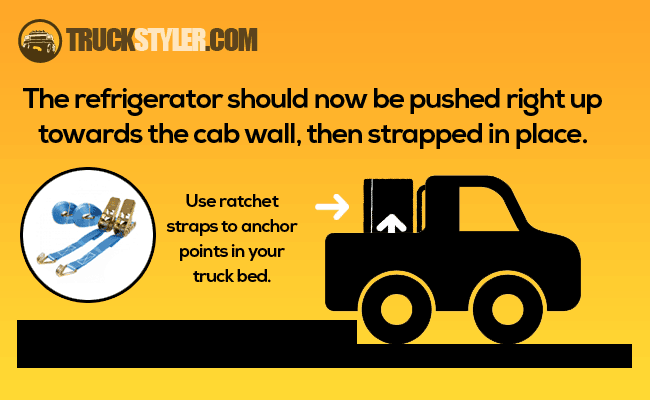
If you have not used ratchet straps before, here are some quick pointers on how to get the best from them.
- Open the ratchet handle, and feed the webbing though the handle from the bottom
- Feed the webbing over the top of your ratchet handle
- Fasten the hooks to the tie down anchor points.
- Pull the webbing tight, removing any slack, to the tension you require.
- Pump the ratchet until your refrigerator is secure
Once tied down, shake and push the fridge to check for movement.
If it feels secure, you’re ready to go.
Take it easy, don’t go too fast, and take corners very slowly.
What Happens Once You Get There?
Getting the refrigerator out of the pickup truck is simply a case of reversing the transport and tie down method shown above.
Once you have the refrigerator in its new home and position, let it sit for at least 3 hours before connecting up to the power.
We do this to prevent any fluids and oils that might have moved during transportation to flow and settle back into the compressor.
If you turn it on too quickly you could damage the fridge freezer.
Handy Hint: Did you know you can make side money with your pickup truck? Find out the best side hustles.
How to Move a Refrigerator Upstairs
One aspect that will always be a challenge is going up stairs and steps.
As with transporting out of the property, you will need to make use of a moving dolly or hand truck, it’s will be lots easier this way.
Back the two wheels of the dolly up against the lowest step and then lift up one step at a time.
The person at the back, preferably two people, will lift the refrigerator from the base as the person holding the dolly handles pulls the stairs from the top.
How to Prevent Floor Scratches
Moving heavy fridges will always run the risk of floor scratches or bunching up and tearing carpets.
To help prevent this, simply take large pieces of cardboard and place them underneath the route where you don’t want to scratch.
Alternatively, you can also use blankets.
Additional Tips
Now you’ve successfully managed to tie down, move, and transport a refrigerator with your pickup truck, there are some other important tips you should also be aware of.
- Don’t move a fridge on its side: The ensure the internal components don’t get damaged, you should always transport the refrigerator standing upright.
- Don’t attempt to do it alone: It’s not impossible to do this yourself, but you run the risk of not only hurting yourself but also damaging the fridge freezer and your truck.
- Don’t switch it back on for at least 3 hours: This will let the oil and fluids flow back into the fridge’s compressor after being transported.
- Don’t leave the refrigerator door closed if in storage: If you intend on leaving in storage, keep the door ajar as this will prevent odors from building up.
- Don’t leave a dirty refrigerator in storage: Make sure it’s completely clean and also free from moisture as this will prevent mold and mildew developing.
Final Word
Of all the items you will ever want to transport in your pickup truck, a refrigerator will undoubtedly be one of the most challenging due to the weight, bulk, and dimensions involved.
But with a little bit of planning and preparation, knowing how to load a refrigerator in a pickup truck should be second nature once you done it for the first time successfully.
By using effective tie down and strapping methods as outlined in this guide, you should help to prevent any damage to the fridge, pickup truck and property, and get from A to B with minimum fuss and stress.
Now you know how to transport a refrigerator in a pickup truck, you can move in confidence and also have the peace of mind in knowing not only you are safe, but also other road users.


